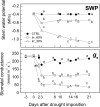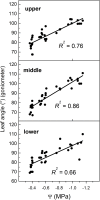Image-Based Assessment of Drought Response in Grapevines
- PMID: 32499808
- PMCID: PMC7242646
- DOI: 10.3389/fpls.2020.00595
Image-Based Assessment of Drought Response in Grapevines
Abstract
Many plants can modify their leaf profile rapidly in response to environmental stress. Image-based data are increasingly used to retrieve reliable information on plant water status in a non-contact manner that has the potential to be scaled to high-throughput and repeated through time. This paper examined the variation of leaf angle as measured by both 3D images and goniometer in progressively drought stressed grapevine. Grapevines, grown in pots, were subjected to a 21-day period of drought stress receiving 100% (CTRL), 60% (IRR 60%) and 30% (IRR 30%) of maximum soil available water capacity. Leaf angle was (i) measured manually (goniometer) and (ii) computed by a 3D reconstruction method (multi-view stereo and structure from motion). Stomatal conductance, leaf water potential, fluorescence (F v /F m ), leaf area and 2D RGB data were simultaneously collected during drought imposition. Throughout the experiment, values of leaf water potential ranged from -0.4 (CTRL) to -1.1 MPa (IRR 30%) and it linearly influenced the leaf angle when measured manually (R 2 = 0.86) and with 3D image (R 2 = 0.73). Drought was negatively related to stomatal conductance and leaf area growth particularly in IRR 30% while photosynthetic parameters (i.e., F v /F m ) were not impaired by water restriction. A model for leaf area estimation based on the number of pixels of 2D RGB images developed at a different phenotyping robotized platform in a closely related experiment was successfully employed (R 2 = 0.78). At the end of the experiment, top view 2D RGB images showed a ∼50% reduction of greener fraction (GGF) in CTRL and IRR 60% vines compared to initial values, while GGF in IRR 30% increased by approximately 20%.
Keywords: 3D imaging; Multi-view stereo; Vitis vinifera; greener fraction; leaf angle; plant phenotyping; water stress.
Copyright © 2020 Briglia, Williams, Wu, Li, Tao, Corke, Montanaro, Petrozza, Amato, Cellini, Doonan, Yang and Nuzzo.
Figures










References
-
- Bailey B. N., Mahaffee W. F. (2017). Rapid measurement of the three-dimensional distribution of leaf orientation and the leaf angle probability density function using terrestrial LiDAR scanning. Remote Sens. Environ. 194 63–76. 10.1016/j.rse.2017.03.011 - DOI
-
- Biskup B., Scharr H., Schurr U., Rascher U. W. E. (2007). A stereo imaging system for measuring structural parameters of plant canopies. Plant Cell Environ. 30 1299–1308. - PubMed
-
- Black C. A. (1965). Methods of Soil Analysis: Part I Physical and Mineralogical Properties. Madison, WA: American Society of Agronomy.
-
- Boso S., Alonso-Villaverde V., Santiago J. L., Gago P., Dürrenberger M., Düggelin M., et al. (2010). Macro-and microscopic leaf characteristics of six grapevine genotypes (Vitis spp.) with different susceptibilities to grapevine downy mildew. Vitis 49 43–50.
LinkOut - more resources
Full Text Sources

